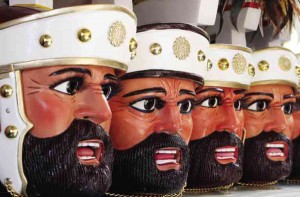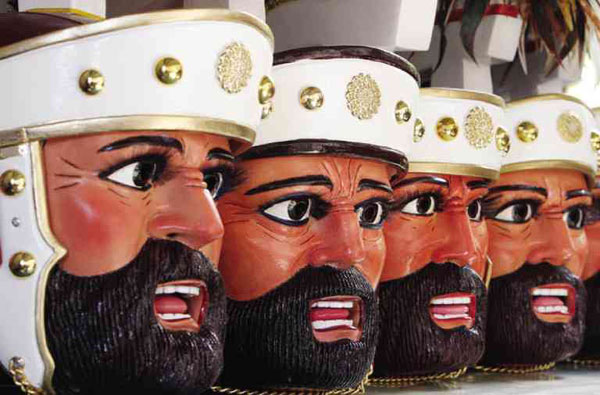
BOAC, Marinduque—Don’t be surprised when you bump into a sword-wielding Roman soldier here these days. He or she is most probably a Marinduqueño behind the traditional centurion mask and the macho-looking armored costume of a “Morion.”
The Moriones is a Lenten tradition observed in the province of Marinduque since the 1800s. People generally believe that wearing the heavy wooden Morion mask and the thick cape, or body armor, as they parade on the streets is an act of penance or a vow.
But in other instances, some Morions also dress up in the traditional costume, which has become an attraction to local and foreign tourists, even when it is not Holy Week. These Morions are oftentimes invited to appear in fiestas or in private resorts, bringing extra income to residents here.
“I am still thinking about it this year. [Resort owners] maybe talking to other [Morion] groups already [otherwise] they should have booked with us by now,” Damaso Palmero, 57, said on Holy Tuesday.
Palmero, known as Ka Dasoy in his hometown Torrijos, is a local Morion mask-maker and a Morion himself. He said four of his fellow Morions in Basyao Senakulo, a group of about 50 Torrijos-based Morions, were invited to last year’s Holy Week commemoration at a private resort in Lucena City, Quezon province.
Entertainers
“They were there just to entertain [the resort’s guests] and to pose for pictures with the tourists,” he said. Each Morion was paid P1,000 a day and was provided free lodging, food and transportation fare by the resort owner.
Similarly, from the town of Gasan, still in Marinduque, Edgardo Santiago, 58, a Morion for six years, said he was invited to an activity in Manila to appear in a Morion costume. He said he was paid P200 per day for a five-day appearance.
Another Morion, Nemesio de los Reyes, 59, said members of Morion League of Bacon-bacon, a local group named after the village where they hailed, were also often invited to fiestas in Batangas and Cavite provinces. Each Morion was paid P1,500 for two days.
“[Being a Morion] is never meant to be a living. It is always voluntary, a vow. But perhaps we can say it has become a sideline, too,” Palmero said.
In the 1970s, a Morion, particularly from Torrijos, was paid P20 to join the Lenten parade. But not anymore in recent years when the municipal government started spending and providing the costumes for Morion volunteers instead, Palmero said.
He said the extra bucks they earned from the out-of-town invitations, although very rare, were a big help to the Morions, who are also “ordinary fishermen and farmers.”
Exposure
Marinduque tourism officer Dindo Asuncion said officials wished to keep the religious facet of the Moriones, which depicts the story of Christ’s passion. This was also the reason, he said, they would rather not call it a festival, which connotes merrymaking.
“The Morions are not street dancers. They’re just there to parade on the streets,” he said.
But over the years, the Moriones festival has also transformed into a weeklong promotional activity for Marinduque as it includes trade expos in the weeklong program. Thousands of local and foreign tourists flock to the island, making the sleepy province alive during the Holy Week.
Hotels and lodgings are easily filled up and the price of seafood also increases during this time, according to residents.
Out-of-town invitations, “in a way, give the Moriones exposure,” Asuncion said.
He said invitations by private individuals were made directly to the Morion groups, except those made by the Department of Tourism for government tourism activities in Manila.
But Asuncion refuses to call the money handed out to the Morions payment, but “a very minimal amount or honorarium, aside from the free lodging and fare.”
“If they give any [amount], then, ‘thank you.’ If not, that’s fine. That’s all right as long as they (other provinces) don’t claim that the Moriones is theirs,” he said.
RELATED STORY
Last of Moriones mask makers looking for heirs









































